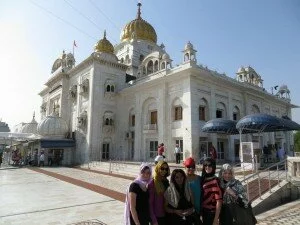It has happened again. Within just a few short weeks we have witnessed two shootings where innocents have died at the hands of a gunman whose reasons escape all logic. We may never be able to understand why someone would walk into a theatre and open fire on movie goers, and we may not know how to prevent it. But when someone walks into a temple and opens fire, the reason behind it is clear. A lack of understanding caused someone to make a false assumption, and because of their personal beliefs they took lives of people worshipping their god. We can’t change what happened in Oak Creek, Wisconsin this evening, but we can prevent it. By educating ourselves and others about what Sikh’s believe and who they are, we can stop the next person from committing a hate crime.
In the CCMBA 2012 program we have 3 Sikh’s who have each made strides to do just that. Ravi Bansal, Raj Jhawar, and Rekha Raju have been wonderful ambassadors of their faith. So rather than only educate our small population of 150 students, here’s my attempt at reaching a larger audience.

Taken by Sonal Patel
When we went to New Delhi, India for Term 4, only a few blocks away from our hotel there was a Sikh temple just like the one in Wisconsin. It was early one morning before classes when 2/3s of the CCMBA Sikh population guided a handful of us to see what the religion was all about. As I walked in wearing jeans and flip flops, the thought crossed my mind that perhaps tourists may not be welcome.
That could not have been further from the truth. Eventually an older gentleman, yes, wearing a turban, walked up and welcomed us. He explained how to check our shoes in, the procedures for washing our hands and feet so we could enter the temple clean, and even provided those of us who needed it with bandannas to cover our hair.
This turbaned gentleman then took us up a staircase where the sounds of scripture being read grew louder and louder. We entered into the sanctuary, which was largely an open floor with an area in the middle where the priest read scripture aloud into a microphone. The Sikh’s worshiping there sat quietly in contemplation and barely moved as they absorbed what was being read.

Photo Taken by Sonal Patel
As tourists we made a loop around the room, and came to a small area at the back of the building where gatherers were congregated. Inside a small room with an elaborate door, the sacred scriptures were housed. We all sat for a few minutes in silence before we exited the temple.
When we exited the temple we were greeted by the same man, this time handing us a special sweet that he insisted we try because it was eaten after the service. While we were wary of how our Western digestive systems would handle this delicacy, we each carefully pinched off a piece and I must admit the honey flavored treat was something I’d try again.
It was at this point that our group was taken to a magnificent oasis in the middle of busy New Delhi. Hidden on the back side of the temple was an amazing wading pool, filled with clean flowing water. With the New Delhi sun already beating down on us so early in the morning, the water looked inviting.
Our tour wasn’t done there. We were taken to a kitchen, where volunteers from the Sikh temple manned a full service kitchen that was open 24 hours a day. They served the poor, the rich, and Western tourists.
As we collected our things we were all grateful to have a small insight into what had always been a foreign religion. Suddenly the mystery and “strangeness” melted away, and there was an understanding, that Sikhism is similar to so many religions we in the West already know.

Debbie Barabe, Ravi Bansal, Neeharika Sinha, Sonal Patel, Jordan Lofton, Kristin Swartz
Now that you have read my description of the Sikh temple in New Delhi, think about the description of what you have heard on the news about the shooting in Wisconsin. Imagine someone walking in to an open room with people sitting on the floor in prayer and opening fire. Imagine the gatherers in front of the Holy Scriptures being cornered by a gunman. Imagine the normal noises of a soup kitchen being interrupted by gunfire and screams. Now imagine, that without saying a word or moving a muscle you could take the gun from this person’s hands and end the violence.
By reading about what your classmate Ravi Bansal has shared below about Sikhism and educating the people you know, you can do just that.
 Ben’s story reminded me of a great article written by the Harvard Business Review focusing on Footlocker’s CEO. Ken Hicks graduated from the US Military Academy and served six years active duty in the Army before he joined the retail world. Just as Ben has, Ken Hicks highlights the importance of valuing people’s service at all levels to achieve a strategic goal. He points out that when leaders at an executive level show respect for and involve the frontline, these employees respond with the same self-sacrifice to work harder and deliver results.
Ben’s story reminded me of a great article written by the Harvard Business Review focusing on Footlocker’s CEO. Ken Hicks graduated from the US Military Academy and served six years active duty in the Army before he joined the retail world. Just as Ben has, Ken Hicks highlights the importance of valuing people’s service at all levels to achieve a strategic goal. He points out that when leaders at an executive level show respect for and involve the frontline, these employees respond with the same self-sacrifice to work harder and deliver results.



